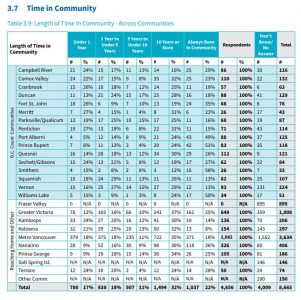The goal of this project was to discuss and inform assumptions regarding migration and homelessness through a presentation and analysis of available evidence, primarily through the review of available Point-in-Time count reports. While the focus of the paper is the context of British Columbia (and features Kelowna data whenever possible), national and international figures and analysis are included throughout. Seven sections of supporting evidence and analysis are presented in the full report, followed by a discussion section. While available evidence and analysis have their limitations, several shared observations have been reported, with important implication for how we might best meet the needs of individuals both experiencing homelessness as well as the broader group of vulnerable members within our society.
Summary Paper: Migration & Homelessness in Canadian Communities: Summary Paper (March 7th, 2022)
Key takeaways from the available sources of evidence described within the full report, or implied from available trends and analysis, include:
- The majority of individuals experiencing homelessness – across a range of diverse Canadian communities – have resided within their community for over a year, if not longer.
- As with the general population, individuals experiencing homelessness move to and from a range of communities across BC, the country, and the world, though movement within provinces is most common.
- Analyses of trends within individual municipality are strengthened when they are compared to the broader context of observations in other communities across the province (and country) at similar time points.
- Migration among those experiencing homelessness is primarily driven by the pursuit of employment opportunities and family supports, though some do relocate to access services.
- Those experiencing homelessness possibly have a higher rate of mobility than the general population.
- Relocating to new communities without an awareness of local supports or their access points can increase or sustain precarity and vulnerability in the absence of interventions to support integration.
- Sustained precarity and vulnerability should be avoided and mitigated when possible, especially if inaction exacerbates negative health, social, and financial outcomes for society.
- Existing service structures could / should have the capacity to identify new arrivals and connect them to their local support sectors to hasten access and more directly link to relevant supports.
Implications for policy, planning, and research revolve around:
- How we communicate facts about experiences of migration within this population;
- How data collection can be used – or supplemented – to better understand migration and other points of potential vulnerability, and
- How existing systems can support new arrivals, as well as those experiencing or at risk of homelessness overall.
Questions are presented for further discussion among relevant stakeholders, and are further elaborated in the full report. They were also developed within the context of the ongoing provincial homelessness strategy development, as well as the ongoing provincial homelessness data integration project.
Potential Implications and Opportunities for Action
Communications
- To what extent can communication regarding homelessness balance messaging where:
- The scope and experience of migration in a given situation is contextualized within the broader collection of experiences across different communities?
- Migration is identified as a potential source of vulnerability (for those actively experiencing homelessness as well as for vulnerable groups generally)?
Data Collection
- To what extent should local planners prioritize enumeration efforts (above and beyond Point-In-Time “PIT” counts) to identify new arrivals experiencing or at-risk of homelessness?
- To what extent and in what form should further data be sought such that it is in keeping with best practices and regulations?
- To what extent would a combined “PIT + By Name List” approach provide complementary sources of local information?
- To what extent can PIT Counts explore the topics highlighted in the full report (length of time in community; prior communities; reported reasons for relocating) in a way that is useful to local, provincial, and / or federal planners and policymakers?
- To what extent can Ministry of Social Development and Poverty Reduction (MSDPR) data be used to track migration of clients experiencing homelessness? What about clients at-risk of homelessness?
- To what extent can other provincial data (e.g. health data) be used to track migration of clients experiencing homelessness? What about clients at-risk of homelessness?
- To what extent can other federal data (e.g. EI, CPP disability, GIS, Census) be used to track migration of clients experiencing homelessness? What about clients at-risk of homelessness?
- And can any of the above sources of data help identify who is at the greatest risk of experiencing homelessness? And if so, to what extent can Integrated Data be made available to communities?
Service Delivery & Planning
- To what extent do / can MSDPR offices serve as a first access point for new arrivals experiencing homelessness, and a link to other local resources (e.g. employment, physical health, mental health, criminal justice questions, etc.)? What about clients at-risk of homelessness?
- To what extent do / can other provincial offices (health, employment, libraries) serve as a first access point for new arrivals experiencing homelessness, and a link to other local resources (e.g. employment, physical health, mental health, criminal justice questions, etc.)? What about clients at-risk of homelessness?
- To what extent do / can Service Canada offices serve as a first access point for new arrivals experiencing homelessness, and a link to other local resources?
- To what extent do / can Service Canada offices serve as a first access point and as a resource link for clients at-risk of homelessness? Including whether additional needs are / can be assessed (e.g. employment, physical health, mental health, criminal justice questions, etc.).
Note as well that the BC Housing Report summarizing the 2020/2021 PIT Counts was released subsequent to the Migration Report:

